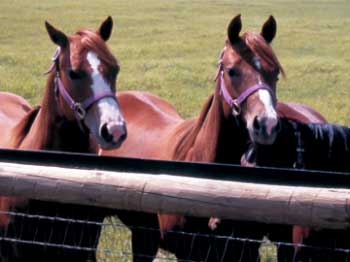Give That Old Fence New Life

But ... budget, time and manpower considerations make installing a new fence system out of the question. What are your options?
There are actually several ways to improve the condition of an existing fence system, but you need to know where to start. First, you need to evaluate the fence in question, making careful notes about the condition of posts, rail, wire, mesh, brackets & whatever materials are used. Prioritize your problems by identifying those areas that need immediate attention to ensure the safe containment of your horses.
Now find an expert with a fencing company or installation contractor. Be prepared to tell them what kind of fence you have; how many rails and of what material (wood, flexible rail, woven wire, mesh, etc.); current post spacing; bracing used (if any) for ends, corners and gate areas; size of the fenced area; number of horses regularly maintained in the area; unusual soil conditions; and the problems you are experiencing. The more information you share and the more questions you ask, the better equipped a fence expert will be to advise you about the solutions available.
You may want to discuss some of the following options with your fence expert:
Adding electric to a spilt rail "broken" fence system. This type of post-and-rail fence generally constructed of wood is referred to as "broken" because the rails are installed as an independent unit from one post to the next post. As a rule, a split rail fence without electric will last anywhere from eight to twelve years with moderate daily use. Install new posts in the place of any that have begun to rot at the base, replace warped or damaged rails, and ensure that you have even soil compaction on both sides of the fence line to prevent loose or leaning posts. Avoid "quick fixes" such as supporting bad posts by driving stakes next to them or tying rails to posts; these can create a hazard for your horses. Supplement your repaired fence with electric wire to minimize cribbing, "walking down", leaning or other equine behaviors that will damage your fence.
Add a top site-rail to mesh fence. First, replace or repair any broken or damaged areas in a woven wire fence. Exercise care in splicing woven wire; each splice needs to be crimped and checked for sharp edges that can cut your horse (or you!). Check tensioning of your woven wire fence and ensure you have proper bracing in place on corners, ends and gateposts. Improve visibility of the fence by adding a top rail of continuous run Flex-Fence. In widths ranging from 1" to 5.25", this type fencing has tremendous break strength, which will alleviate the load on the woven wire.
Test existing electric systems. Regularly check electric fence systems to ensure the entire fence is "live." Fence testers are available for around $14; a minimal investment to ensure your fence is working as it should. Any broken or damaged runs of electric tape or wire are relatively easy and inexpensive to repair by splicing. Ensure that posts are solid and straight. Be sure you have a sufficient number of ground rods for your system.
Ensure proper post spacing. For all fence systems containing horses, posts should be spaced at no more than 12'. Generally, a need for more than normal levels of maintenance may indicate inadequate post support for your fence. If your current fence has post spacing of 15' or more, you should consider adding posts to better distribute the pressure that your horses and the weather place on a fence.
Your horses probably spend 50 to 100 percent of their time in a pasture surrounded by fence. Make sure you maintain a safer, strong living space for your equine friends.
 Debbie has over 45 years experience with horses and equine-related businesses. She has owned, trained, boarded horses and run stables at various times in her career. She is a certified fence installer, has given balanced riding lessons, and has shown horses in Western, Western Pleasure, Trail, English, Hunter/Jumper, Fox Hunting, Hunter Trials, Dressage and driving classes. Debbie has been involved in foaling, and just about every aspect of horse ownership possible, and she welcomes your questions and comments. If you are interested in using any articles by Debbie, please send her an email.
Debbie has over 45 years experience with horses and equine-related businesses. She has owned, trained, boarded horses and run stables at various times in her career. She is a certified fence installer, has given balanced riding lessons, and has shown horses in Western, Western Pleasure, Trail, English, Hunter/Jumper, Fox Hunting, Hunter Trials, Dressage and driving classes. Debbie has been involved in foaling, and just about every aspect of horse ownership possible, and she welcomes your questions and comments. If you are interested in using any articles by Debbie, please send her an email.
RAMM Fence Systems, Inc. makes every effort to provide reliable and useful information on horse health, care and products. The statements made on this website are based on years of experience with horses, however, they are based on generalized situations and should not replace diagnosis or treatment by a veterinarian or consultation by a professional. RAMM Fence Systems, Inc. does not assume any legal responsibility. Readers should always consult qualified health care providers for specific diagnosis and treatment.
